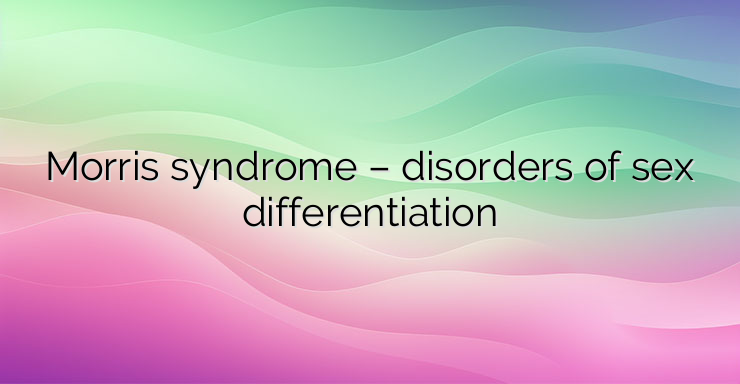Morris syndrome, also called testicular feminization, is a disturbance of the development of primary and secondary sexual characteristics in men with a normal karyotype in connection with a complete or partial defect in the receptors for androgen hormones and resistance to their action. The syndrome is X-linked (linked to the sex chromosome X), recessively inherited. Over 200 different mutations in the androgen receptor gene have been described, affecting to one degree or another the function, androgen sensitivity and phenotype. The lack of stimulation by testosterone even prenatally leads to a disturbance in the development of the external sexual organs and they are formed as female ones with complete resistance. In partial defects, the phenotype varies from mildly virilized female genitalia to discrete abnormalities in external male genitalia and underdeveloped internal ones. At the same time, the preserved secretion of another hormone (the so-called anti-Müllerian hormone) from the otherwise available testicles, albeit in the abdominal cavity, prevents the development of female genital organs such as the uterus, fallopian tubes, ovaries. The vagina ends blindly. Androgen resistance prevents the formation of internal sex organs from the opposite sex. With absolute androgen resistance at birth, there is usually no doubt about the sex of the child and it is raised as a girl. Children also grow up with such an awareness. Puberty marks appear a little later than usual, such as breast growth to normal female sizes. Genital and armpit hair is absent, the skin is very delicate, the body is slender, and the height is taller than that of the average woman. The reason for diagnosing the male genotype is the absence of menstruation. Physical examination reveals a blind-ending vagina. The testicles are located in the abdomen, in the inguinal canal, in the labia majora. The latter is the other frequent reason for the diagnosis of the syndrome. The reason for the formation of glands and other marks in the structure of the body, typical for the female sex, is the high level of estrogens. Since at the level of the hypothalamus there is also resistance to otherwise normal levels of testosterone, even more powerful stimuli for the production of sex hormones arise from there. Androgens in peripheral tissues are metabolized to estrogens, resulting in their high level in individuals with Morris syndrome, in contrast to healthy men. For the diagnosis, the normal karyotype – 46, XY (sex constellation), high levels of hormones – luteinizing, testosterone and its metabolites and other androgens, estrogens (the former more pronounced in partial, and the latter – in absolute resistance) are important for the diagnosis. DNA analysis proved the mutation in the androgen receptor. Ultrasound of the small pelvis shows the absence of the uterus and adnexa. Treatment for Morris syndrome includes hormone replacement therapy and, of course, psychological support. The first step after the condition is diagnosed is to remove the testicles,except in cases of mild forms and with definite extra-abdominal distribution. High abdominal temperature increases the risk of male gonadal malignancies. In case of complete androgen resistance, estrogen replacement therapy is started. The inclusion of progesterone is not justified in the absence of a uterus. In the partial forms, in which insufficient virilization is present, exogenous testosterone or dehydrotestosterone can also be administered. Sometimes, some reconstructive operations are also carried out – such as lengthening the vagina in case of an absolute defect. Cosmetic operations are also necessary for partial forms.


Leave a Reply